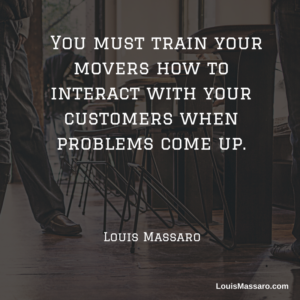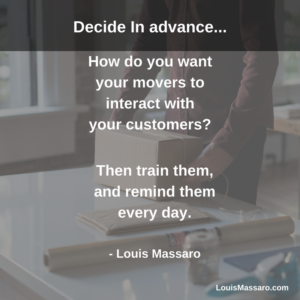What exactly do I mean when I say train your movers in customer service?
For starters, your movers should start each move with the intention of making a great first impression and placing the customer at ease. They can do this by:
- Showing up on time
- Have a clean truck, with the back swept out and neatly folded pads
- Be in company uniform
- Introduce the crew to the customer upon arrival
- Inform the customer of each mover’s role in their move
- Helpers should walk up to the door with pads
- Helpers should start protecting floors, rails, and door jambs
- Make the customer feel comfortable
That will set the tone and let the customer know they have professionals handling their belongings. When a customer hires a professional moving company, they expect more than someone to just move their furniture from point A to point B. They expect to deal with respectful, courteous, professional movers. Make sure they feel that right away!
How is the customer supposed to feel if you show up and open the back up the truck where their furniture is going and it’s a mess? There are pads and boxes everywhere and there is a guy in the back of it smoking a cigarette. Do you think they will feel good about their choice in moving companies?
So as a moving company owner, what do you need to do?
- Decide how you want each move to be conducted
- How do you want your movers to introduce themselves to the customer?
- What do you want them to do before they leave the pickup?
- What should they do at the end of the move?
- How should they deal with problems that may come up?
If you want to provide a consistent service, which you do. Then you need to think these things through ahead of time and then train your movers on it. After you train them, you also should remind them daily if needed.
This is how you are going to get more repeat and referral customers. This is how you are going to get 5-star reviews.
Your movers and all of your employees are a reflection of you and your company. How do you want to be represented?
Watch the video above for the full episode.
Like this episode? Please share it! My blog and videos are ad-free ONLY because you share my work!
How can I help? What challenges are you facing in your business? What areas could you use some tips in?
Leave me a comment below and I will be more than happy to get back to you or post a video on the topic.
Follow Louis on Instagram for tons of great quotes.




Full Transcript
[The following is the full transcript of this episode.]
Hey my friend, it’s Louis Massaro, author of 10 Rules Of A Profitable Moving Company and founder of Moving Mastery. Are you training your movers in customer service or are you only training them on how to move furniture? Because rule number seven of the 10 Rules Of A Profitable Moving Company is train your movers in customer service. This is so important. They are the face of your company. They’re the ones that are gonna be interacting with your customer. How is it that you want that interaction to go? You can’t just expect them to know it. Too many times, moving companies are just giving out the contracts, saying, “Do you have enough helpers? Do you have everything you need? Okay, good, go.” But they’re not training the movers in how they want them to interact with the customer and the customers are expecting more than just showing up and moving your furniture from point A to point B. First impression goes a long way. How the movers show up at the house and the first few things they do set the tone for the whole move.
I used to tell my guys this repeatedly, “When you show up and your truck is clean and the pads are folded and it’s swept out, you’re in uniform and you walk up to the customer and you introduce yourself, and you introduce your crew, and you make them feel comfortable, all their worries and anxieties about the move go down.” And they’re like, “Okay, good. I got some good guys here, these guys are gonna do a good job, they’re gonna take care of me.” But when you show up and one guy is out by the truck smoking a cigarette and you just say, “Hey, what’s up? We’re here to move you,” you don’t really start the whole thing off right, you set a bad tone for the move and now the customer could be complaining about stuff that isn’t even relevant, they just don’t feel right about the situation. So you have good crews, you have some crews that don’t do this thing on their own.
But what if you train them? What if you trained every single mover that this is how things need to be done? When you show up to the home, the first thing you need to do is the driver needs to walk up to the house, the helpers need to have some pads on their shoulders or under their arms and walk up with him. The driver should introduce himself and the crew and explain to the customer, “I’m gonna be handling this, he’s gonna be handling that, they’re gonna be handling that,” and explain what’s gonna be going on. Put the customer at ease. Then the helpers could start right away, they can go and pad-wrap some furniture or some rails or protect the doorways and do things to just set a good first tone. So, that’s the start of the move.
How do you want them to end the move? What’s your company’s policy for the end of the move? At the end of the pickup, should they go and get the customer and say, “Can you look around and make sure that we got everything? Is there anything else you want us to do before we leave?” At the drop off, “Is everything where you’d like it to be? Is there anything else we can do?” These things need to be thought out by you and then trained. You need to train your movers on them. You can’t just let them go out and do it how they wanna do it because you know what? Then essentially, your company is gonna be an accumulation of how this driver, this driver, this driver, these movers, these movers and these movers would run their company. No, it’s your company. Have things done in a consistent way by everybody. The consistency is key.
So if you think these things out in advance, it won’t take much to train your staff and your movers to do things how you want them to be done. It also goes for a problem on the job or an unforeseen circumstance. How do they handle that? They need to be trained. Something happens, I don’t know, a piano falls down a whole flight of stairs. It happens. So what do they do? What’s the first thing that they do? The movers need to know, they’re in a tough spot. They’re there face-to-face with the customer. The customer is yelling at them, they’re pissed off. What do they do? You need to decide that. Do they need to never engage with the customer when there’s a problem and always say, “Let me call the office and let you speak to the dispatcher or let you speak to the owner or whoever?” Or are you gonna train them to deal with these situations? That’s for you to decide.
But what you do need to decide and what I’m telling you do need to do is that you need to make those decisions ahead of time and then train your movers on them. It’s something that it’s gonna go a long way for creating raving fans, it’s gonna go a long way for getting more five-star reviews and it’s just gonna create a more, a smoother environment and you’re not gonna have movers that are out just doing whatever they wanna do. It’s about, “You work for this company, you work for my company and this is how we do things here.” And if certain guys don’t wanna get with the program, then maybe they’re not made to work for your company. Maybe they should go open their own company, maybe they should go work for a different company. But at your company, how do you want things done? Because every single employee that you have, every single person that you put in the face of a customer or put on the phone with a customer is a reflection of you and your company. So you need to think about that and you need to think about if you were out on the move, how would you handle it? How would you introduce yourself to the customer? How would you deal with a problem if it came up? So how would you want your men and your movers to do that or women to go out and handle every single interaction on the move?
So rule number seven of 10 Rules Of A Profitable Moving Company, train your movers in customer service. Don’t just train them on how to move furniture, train them on how to interact. So when you’re doing your training, it doesn’t take much extra time to do this. So when you bring on new staff, you train them, obviously. Even if they already know how to move furniture, you’re gonna re-train them so that you make sure that you see that they know what they’re doing. But then also give them the checklist, “There are the things that need to happen. If these problems come up, this is what you need to do.” And every day, remind them of that. Listen, ’til next time, continue to profit in business, thrive in life. I’ll see you later.
